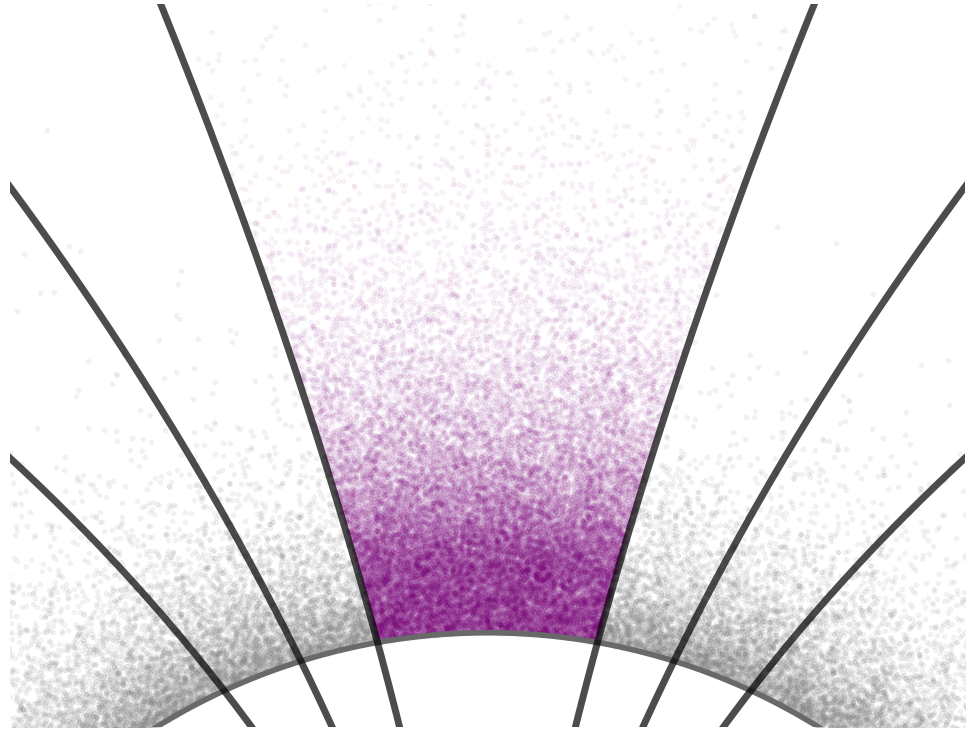Description
The «Swarm+ investigation of energetic ion up/outflow» («Swarm+ Outflow») project was led by Dr. Spencer Hatch at the Birkeland Centre for Space Science from May 2019 to March 2021.
The central purpose of the Swarm+ Outflow project was to determine if Swarm spacecraft measurements of ionospheric plasmas and electromagnetic fields, together with measurements from other satellite missions and ground-based instruments, can be used to fill knowledge gaps related to the phenomenon of «energetic ion outflow» (the intense loss of ionospheric-origin ions within and near the high-latitude auroral zone). The answer is a resounding «yes!»
The project consisted of five lines of inquiry:
- Swarm-EISCAT conjunctions: Correlated electron temperatures, upward flow velocities, and small-scale B-field fluctuations;
- Swarm Echo: correlated upward flow velocities and field fluctuations;
- Swarm-Cluster conjunctions;
- Correlation between Swarm measurements of small-scale electromagnetic waves and ion upward velocity, electron temperature, and electron density;
- Variation in F-region polar cap plasma density with season, hemisphere, and geomagnetic activity.
We found that all five of these lines of inquiry constitute viable pathways for understanding both energetic ion outflows and cold ion outflows.
Publications
- Study 1 – Hatch et al. (2020a), JGR: Space Physics –
«Relationship between cusp-region ion outflows and east-west magnetic field fluctuations in Southern and Northern Hemispheres,» doi:10.1029/2019JA027454 - Study 2 – Hatch et al. (2020b), JGR: Space Physics –
«Seasonal and Hemispheric Asymmetries of F Region Polar Cap Plasma Density: Swarm and CHAMP Observations,» doi:10.1029/2020JA028084 - Study 3 – Hatch et al. (in preparation), «The role of geomagnetic activity and solar wind driving in the cold ion outflow source region: Swarm and CHAMP observations of F-region polar cap plasma density» (PDF of EGU 2020 presentation)
Results
Key points FROM STUDY 1 (Hatch et al., 2020a)
- «Summer/equinox outflows and east-west magnetic field fluctuations are highly correlated (r > 0.92)»;
-
«Winter outflows are poorer in oxygen and less correlatedwith magnetic field fluctuations (r > 0.75)»;
-
«Power indices 0.7–1.2 characterize statistical relationship between outflows and magnetic field fluctuations»;
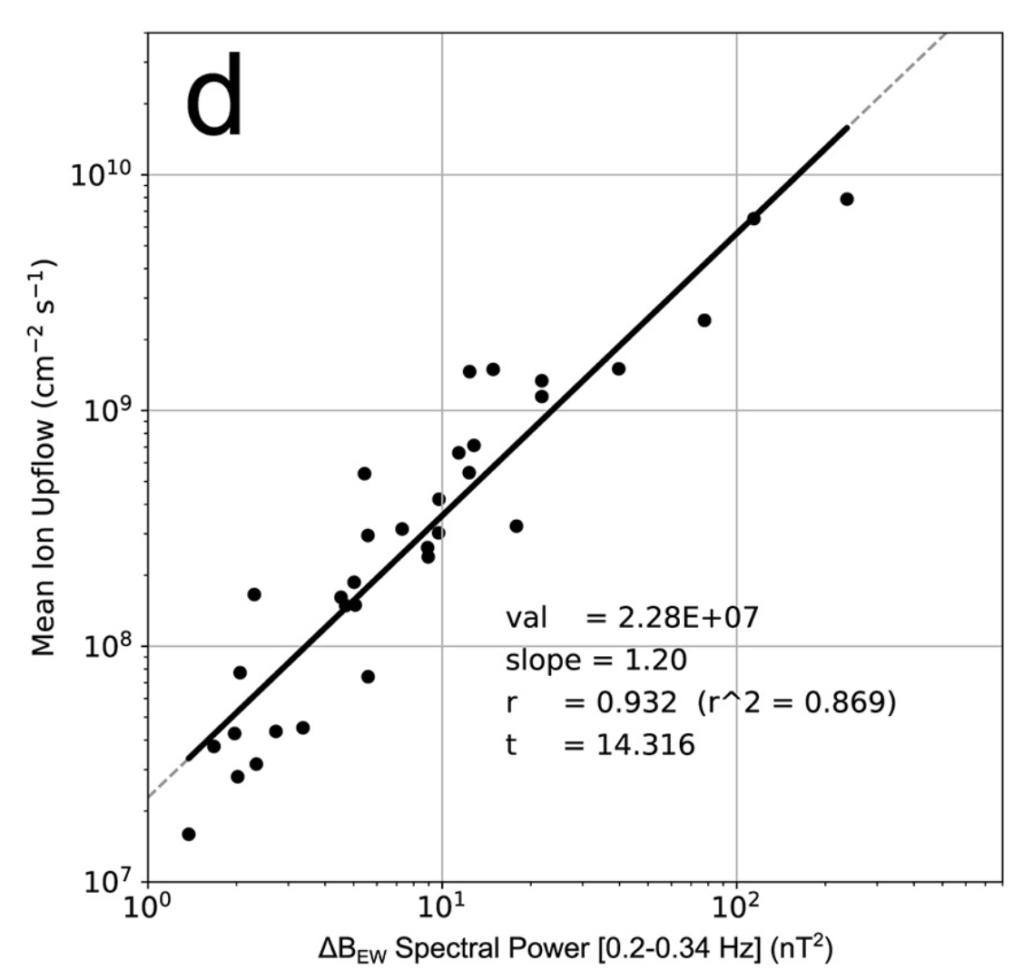
Least squares linear fit between average oxygen outflow and east-west magnetic field fluctuations for spacecraft frame frequency band 0.2–0.34 Hz around September equinox in the Northern Hemisphere. The correlation coefficient is r = 0.932. The power-law slope is 1.2. The slope is decreased during winter months, and the mean ion upflow fluxes are generally higher as they are more hydrogen-rich and oxygen-poor—that is, the outflows are composed of lighter ions. (Figure 3d in Hatch et al, 2020a.) - Magnetic field perturbations observed by FAST are not inconsistent (which is not the same as being consistent!) with Doppler-shifted Alfvén waves.
KEY POINTS FROM STUDY 2 (Hatch et al., 2020b)
- «Statistics of F region polar cap plasma density derived from 15 years of measurements exhibit several types of seasonal asymmetries»;
- Statistics do not support the Haaland et al. (2017) conjecture that limited plasma availability is the cause of the observed
hemispheric asymmetries in lobe density that Cluster observes;
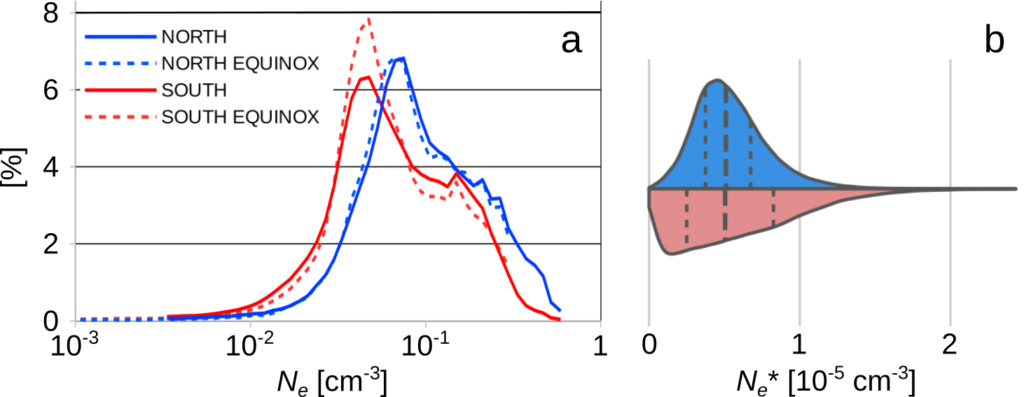
(a) Distribution of ionospheric-origin cold plasma density (i.e., cold outflow) measured by Cluster spacecraft. The dashed lines show distributions from the Northern (blue) and Southern Hemisphere (red) within 10 days of September equinox on a logarithmic axis. Adapted from Figure 2a in Haaland et al. (2017). (b) Distribution of F-region polar cap plasma density in the Northern (blue) and Southern (red) Hemispheres within ±15 days around September equinox on a linear axis. For each distribution the thick dashed line indicates the median, and the two thin dashed lines indicate the first and third quartiles. Adapted from Figure 2f in Hatch et al. (2020b). - «Southern Hemisphere polar cap plasma densities lag those in
Northern Hemisphere by at least 2 weeks around local spring and fall equinox.»
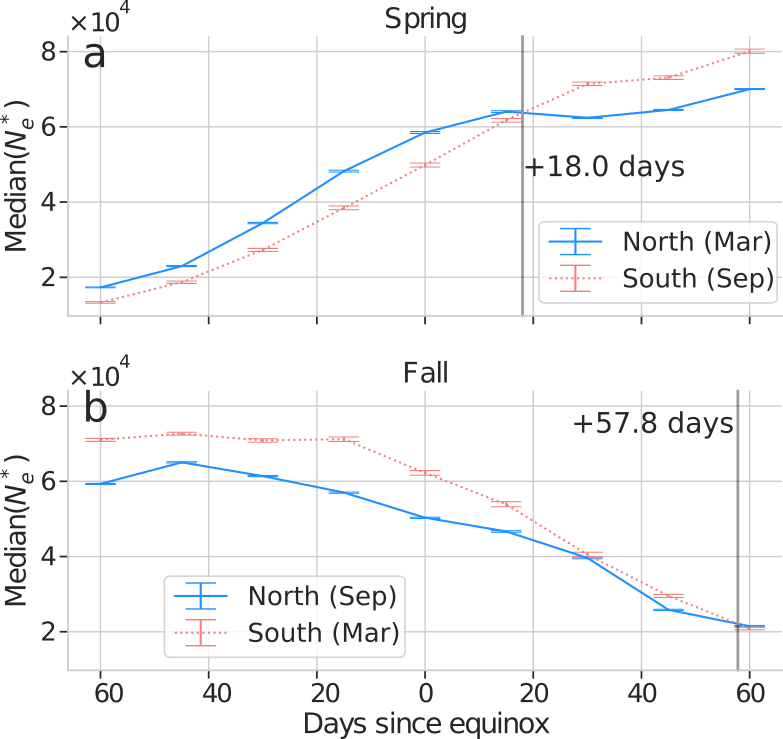
Median height- and solar activity-adjusted polar cap (≥ 80° Mlat) density in 15-day bins the NH (blue) and SH (red) around (a) local spring equinox and (b) local fall equinox. The horizontal bars indicate the 95% confidence intervals of the medians. Adapted from Figure 3 in Hatch et al (2020b).
KEY POINTS FROM study 3 (IN PREPARATION)
-
During local summer (top row), polar cap Ne* distributions are shifted to lower densities during high solar wind driving relative to the Ne* distributions under low solar wind driving. During local winter (bottom row), polar cap Ne* distributions are shifted to higher densities during high solar wind driving relative to the Ne* distributions under low solar wind driving.
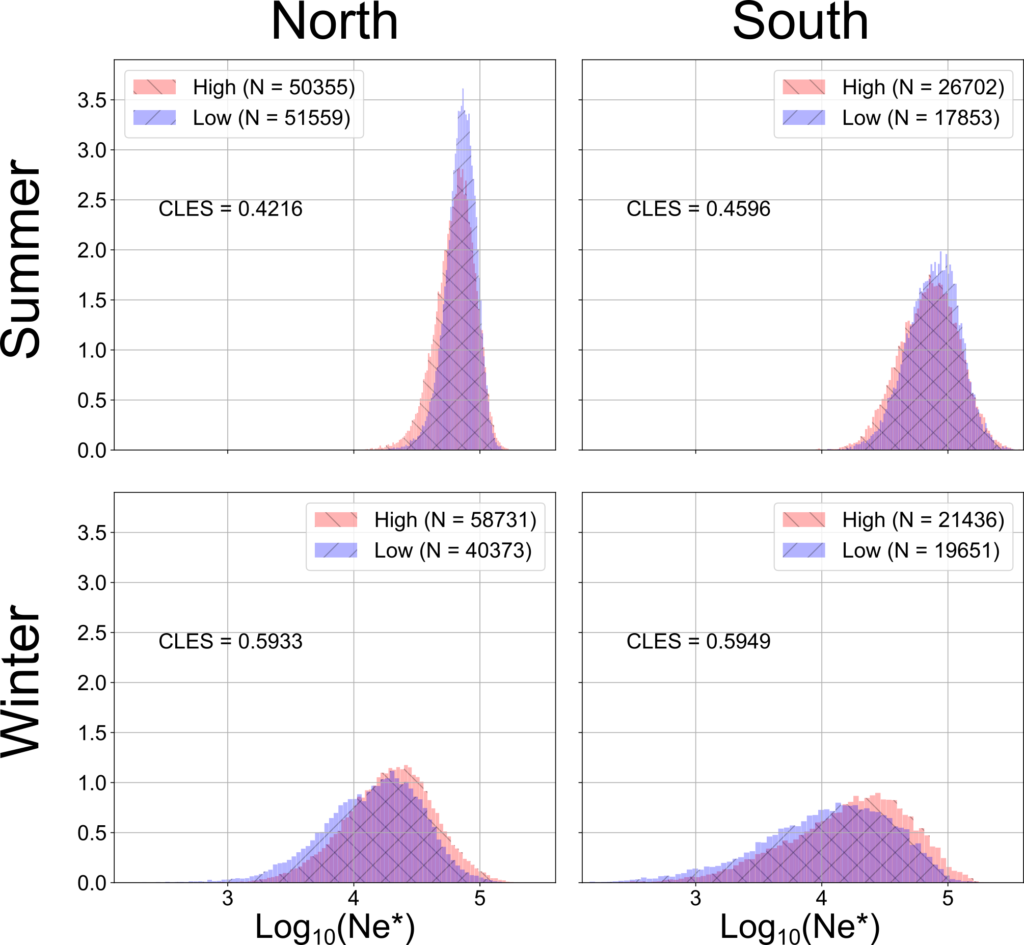
Distributions of height- and solar activity-adjusted polar cap (Ne*) measurements made by the Swarm and CHAMP satellites during low (blue) and high (red) solar wind driving in the Northern Hemisphere (NH, left-hand column) and Southern Hemisphere (SH, right-hand column). The top row shows statistics from ±15 days around local summer solstice (June solstice in the NH, December solstice in the SH). The bottom row shows statistics from ±15 days around local winter solstice (December solstice in the NH, June solstice in the SH). The axes in all panels are equal.
Presentations
- (31 Jan 2021) «Hemispheric and seasonal variations in the cold plasma outflow source region: Swarm and CHAMP observations of F-region polar cap electron density» (COSPAR-21-C1.4-0007-21), 43rd COSPAR Scientific Assembly
- (06 May 2020) «Hemispheric and seasonal variations in the cold plasma outflow source region: polar cap ionosphere electron density at 350–500 km» (EMRP2.2, EGU2020-21247), EGU General Assembly: Sharing Geoscience Online, doi:10.5194/egusphere-egu2020-21247
- (19 Sep 2019) Swarm Data Quality Workshop presentation, Prague, Czech Republic (PDF)
Data sources
- CHAMP and Swarm solar activity- and height-scaled polar cap plasma density measurements (doi:10.5281/zenodo.3813146)
- List of conjugate observations used
- Swarm-EISCAT conjunction list
- Swarm-Cluster conjunction list
- (Swarm-Cluster Near-earth EM environment)
- (Swarm-E/e-Pop)
- Combined Swarm/CHAMP F-region plasma density database, adjusted for differences in solar activity and altitude
Funding
Swarm+ Outflow is a project funded by the European Space Agency (contract no. 4000126731/19/NL/IA) in the framework of the Swarm+ Coupling: High-Low Atmosphere Interactions program.
Internal wiki (team members only)
https://wiki.uib.no/swarmoutflowinternal/index.php/Swarm%2B_Outflow_Internal_Wiki Link
